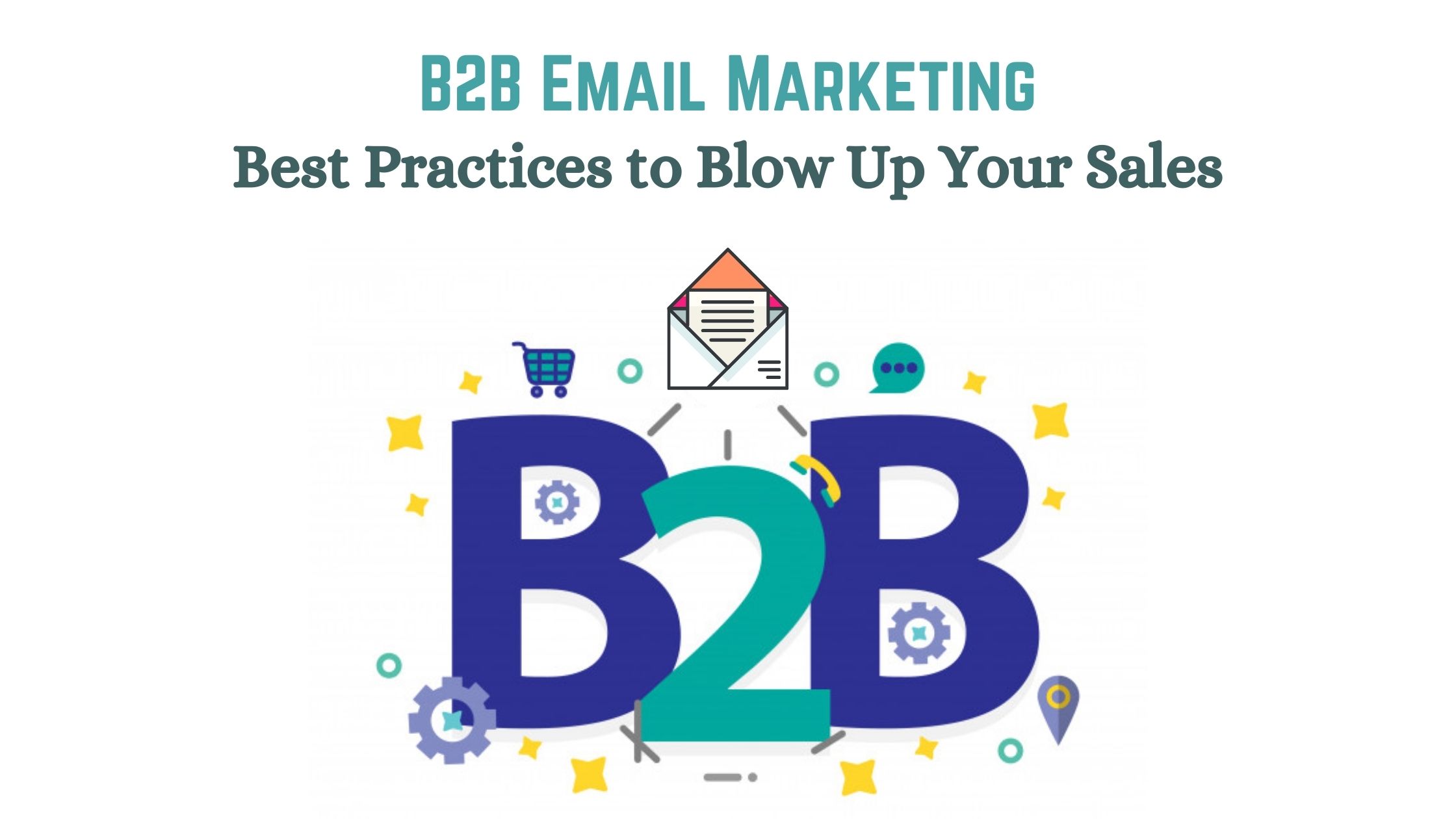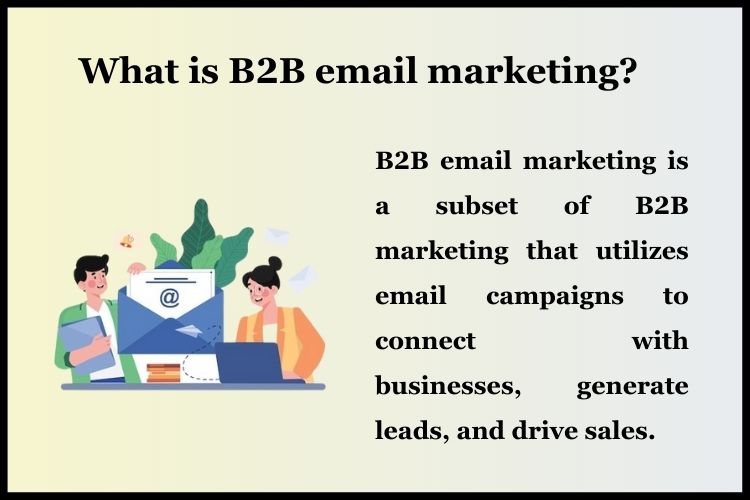B2B Email Marketing...
B2B Email Marketing Best Practices to Blow Up Your Sales

B2B Email Marketing Best Practices to Blow Up Your Sales
In the ever-evolving landscape of digital marketing, B2B email marketing stands out as a powerful tool for businesses aiming to boost sales and engage with their target audience effectively. Understanding the best practices in this realm is crucial for leveraging the full potential of email campaigns. In this blog post, we’ll delve into the world of B2B email marketing, exploring its fundamentals, best practices, and examples that can significantly impact your sales strategy.
How do B2B email marketing best practices help boost sales?
B2B email marketing best practices are designed to optimize communication between businesses, fostering relationships and driving sales. By adhering to these practices, companies can enhance their brand visibility, build trust with potential clients, and ultimately convert leads into loyal customers.
What is Email Marketing?
What is B2B Marketing?

What is B2B email marketing?
B2B email marketing is a subset of B2B marketing that utilizes email campaigns to connect with businesses, generate leads, and drive sales. It involves creating targeted and personalized content to engage with decision-makers in a way that addresses their unique challenges and needs.
B2B email marketing best practices
1: Segmentation and Targeting:
Divide your audience based on industry, company size, or other relevant factors to tailor your messages for maximum impact.
2: Personalization:
Craft personalized and relevant content that speaks directly to the recipient’s business needs, increasing the likelihood of engagement.
3: Compelling Subject Lines:
Grab attention with compelling subject lines that encourage recipients to open and read your emails.
4: Mobile Optimization:
Ensure your emails are mobile-friendly, as many professionals check emails on their smartphones.
5: Clear Call-to-Action (CTA):
Clearly guide your audience on the next steps you want them to take, whether it’s downloading a whitepaper, requesting a demo, or making a purchase.
6: Analytics and Testing:
Regularly analyze campaign performance and conduct A/B testing to refine and optimize your email strategy.
B2B email marketing tips
1: Consistency is Key:
Maintain a consistent sending schedule to keep your brand top-of-mind without overwhelming recipients.
2: Use Visuals Wisely:
Incorporate visually appealing elements to break up text and make your emails more engaging.
3: Build Trust with Transparency:
Clearly communicate your value proposition and be transparent about your offerings to build trust with your audience.
4: Follow GDPR Compliance:
Ensure that your email marketing practices comply with data protection regulations to build trust and avoid legal issues.
What is the distinction between B2C and B2B email marketing?
The distinction between B2C (business-to-consumer) and B2B (business-to-business) email marketing lies in the target audience, the complexity of the purchase decision process, and the communication strategies employed. Here are the key differentiators:
1: Target Audience:
B2C: Targets individual consumers or end-users.
B2B: Targets businesses and professionals who make purchasing decisions on behalf of their organizations.
2: Purchase Decision Complexity:
B2C: Typically involves a shorter and less complex decision-making process. Consumers often make impulse purchases based on emotional triggers or immediate needs.
B2B: Involves a more intricate and lengthy decision-making process. Purchases are often made by a group of decision-makers who assess various factors, including budget, long-term value, and alignment with business objectives.
3: Communication Strategies:
B2C: Focuses on creating emotional connections and engaging consumers through persuasive, visually appealing content. Often relies on promotions, discounts, and brand loyalty to drive sales.
B2B: Prioritizes building professional relationships and providing detailed, informative content. Decision-makers in B2B environments are more likely to respond to data-driven and solution-oriented communication that addresses specific business challenges.
4: Content and Messaging:
B2C: Content is often more straightforward, emphasizing the benefits and emotional appeal of products or services. Messaging is designed to resonate with individual preferences and lifestyle choices.
B2B: Content tends to be more detailed, focusing on the features, specifications, and practical applications of products or services. Messaging is tailored to address the unique needs and challenges of businesses, showcasing how the offering can provide value on a larger scale.
5: Relationship Building:
B2C: Relies on building a brand-consumer relationship to encourage repeat purchases and brand loyalty. Communication is often one-way, with the brand providing information and promotions to the consumer.
B2B: Prioritizes building long-term, collaborative relationships. B2B relationships often involve ongoing communication, negotiation, and customization of products or services to meet the specific needs of the business.

How B2B marketing and B2C marketing is different?
Understand the nuances that differentiate B2B marketing from B2C email marketing, including the length of the sales cycle, the number of decision-makers involved, and the importance of relationship-building in B2B transactions.
B2B lead generation using Email
Learn effective strategies for B2B lead generation through email marketing, including lead magnets, targeted content, and personalized outreach to nurture leads through the sales funnel.
Conclusion
In conclusion, mastering B2B email marketing best practices is essential for businesses aiming to elevate their sales strategy. By understanding the unique dynamics of B2B communication, implementing personalized and targeted approaches, and staying abreast of industry trends, businesses can leverage email marketing as a potent tool for growth and success in the competitive B2B landscape. A good email marketing service like Deliver2inbox can help you with your campaigns.
Frequently Asked Questions
Q1: How can B2B email marketing benefit my business in terms of sales growth?
B2B email marketing can significantly boost sales by fostering stronger relationships with other businesses, enhancing brand visibility, and providing a targeted approach to engage decision-makers.
Q2: What sets B2B email marketing apart from B2C email marketing?
While both B2B and B2C email marketing share the basic premise of using email as a communication tool, they differ in terms of target audience, purchase decision complexity, and communication strategies. B2B email marketing focuses on building professional relationships and addressing the unique needs of businesses, whereas B2C marketing targets individual consumers with a more straightforward purchasing process.
Q3: How can I effectively use email newsletters in B2B marketing?
B2B email newsletters should offer valuable content, updates, and exclusive offers to engage subscribers. By studying successful B2B email newsletter examples, businesses can understand the key elements that contribute to their success, such as informative articles, visually appealing designs, and a consistent delivery schedule